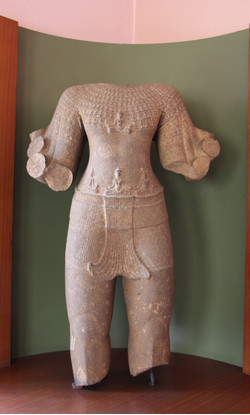ค้นหางานศิลปกรรม
ฐานข้อมูลศิลปกรรมในเอเชียตะวันออกเฉียงใต้
พระโพธิสัตว์อวโลกิเตศวรเปล่งรัศมี
คำสำคัญ : ปราสาทเมืองสิงห์, อวโลกิเตศวร, พระโพธิสัตว์, พระเจ้าชัยวรมันที่ 7, พระอวโลกิเตศวรเปล่งรัศมี
| ชื่อหลัก | พิพิธภัณฑสถานแห่งชาติ ราชบุรี |
|---|---|
| ประเภทงานศิลปะ | ประติมากรรม |
| ตำบล | หน้าเมือง |
| อำเภอ | เมือง |
| จังหวัด | ราชบุรี |
| ภาค | ภาคตะวันตก |
| ประเทศ | ไทย |
| พิกัดภูมิศาสตร์ ค่าองศาทศนิยม | Lat : 13.541034 Long : 99.817664 |
| พิกัดภูมิศาสตร์ พิกัดกริด | Zone : 47 P Hemisphere : N E : 588475.33 N : 1497116.04 |
| ตำแหน่งงานศิลปะ | จัดแสดงภายในพิพิธภัณฑสถานแห่งชาติ ราชบุรี |
| ประวัติการสร้าง | เช่นเดียวกันกับพระโพธิสัตว์อวโลกิเตศวรเปล่งรัศมีที่พบจากเมืองสิงห์ที่ไม่ปรากฏหลักฐานเอกสารที่เกี่ยวข้องกับประวัติการสร้าง แต่จากรูปแบบทางศิลปกรรมที่เป็นศิลปะเขมรแบบบายนจึงกำหนดอายุได้ราวพุทธศตวรรษที่ 18 สมัยพระเจ้าชัยวรมันที่ 7 นักวิชาการบางท่านเชื่อว่าโบราณสถานสระโกสินารายณ์ที่ค้นพบประติมากรรมนี้น่าจะเป็นชุมชนในวัฒนธรรมเขมรที่ถูกเอ่ยถึงในจารึกปราสาทพระขรรค์ โดยเฉพาะอย่างยิ่งเมืองศามพูกปัฏฏนะซึ่งพระเจ้าชัยวรมันที่ 7 โปรดให้ส่งพระชัยพุทธมหานาถมาประดิษฐานไว้ หากข้อสันนิษฐานข้างต้นนี้เป็นจริงก็อาจตั้งข้อสังเกตถึงความใกล้ชิดระหว่างเมืองพระนครกับสระโกสินารายณ์ได้ จนอาจตั้งคำถามต่อเนื่องได้ว่าประติมากรรมพระโพธิสัตว์อวโลกิเตศวรเปล่งรัศมีองค์นี้เป็นสิ่งที่สร้างขึ้นในเมืองพระนครแล้วถูกส่งมาประดิษฐานที่เมืองสิงห์เช่นเดียวกันกับพระชัยพุทธมหานาถได้หรือไม่ |
|---|---|
| กระบวนการสร้าง/ผลิต | หินทรายแกะสลัก |
| ประวัติการอนุรักษ์ | ค้นพบที่โบราณสถานสระโกสินารายณ์ อำเภอบ้านโป่ง จังหวัดราชบุรี |
| ลักษณะทางศิลปกรรม | พระโพธิสัตว์อวโลกิเตศวรเปล่งรัศมีอยู่ในอิริยาบถยืนตรง พระเศียร พระกร และระชงฆ์ตลอดจนพระบาทชำรุดหักหายไปหมดแล้ว บริเวณพระอุระตลอดจนพระอังสา (ไหล่) และพระพาหา (ต้นแขน) ประดับด้วยแถวพระพุทธรูปจำนวนมากมายราวกับเป็นเกราะ กึ่งกลางพระอุระและบั้นพระองค์ปรากฏรูปบุคคลขนาดใหญ่อาจหมายถึงนางปรัชญาปารมิตา สวมสมพตสั้นที่สลักลวดลายอย่างคร่าวๆ ช่วงล่างของพระองค์ตั้งแต่พระอูรุ (ต้นขา) ใหญ่ผิดสัดส่วนตามแบบประติมากรรมในศิลปะบายน |
| ข้อมูลที่สำคัญทางวิชาการ | ประติมากรรมนี้แม้ว่าจะอยู่ในสภาพชำรุดมาก แต่ก็เพียงพอที่จะระบุว่าเป็นพระโพธิสสัตว์อวโลกิเตศวรเปล่งรัศมีศิลปะเขมรแบบบายน อายุราวพุทธศตวรรษที่ 18 ค้นพบที่โบราณสถานรสระโกสินารายณ์ อำเภอบ้านโป่ง จังหวัดราชบุรี นับเป็นหลักฐานที่แสดงให้เห็นถึงความสัมพันธ์ใกล้ชิดระหว่างดินแดนภาคตะวันตกของไทยกับกัมพูชาในสมัยพระเจ้าชัยวรมันที่ 7 ได้ดียิ่ง นอกจากนี้ยังแสดงถึงการเจริญขึ้นของพุทธศาสนามหายานในดินแดนไทยด้วย |
| ข้อสังเกตอื่นๆ | พระโพธิสัตว์อวโลกิเตศวรเปล่งรัศมีสร้างขึ้นจากความเชื่อว่าพระองค์เป็นผู้ยิ่งใหญ่ที่สุดในจักรวาล ขุมขนหนึ่งๆ คือหนึ่งจักรวาลที่บรรจุอยู่ภายในพระวรกาย แสดงออกมาโดยแถวพระพุทธเจ้าที่รายรอบทั่วพระองค์ส่วนบนและพระเศียร |
| ยุค | ประวัติศาสตร์ |
| สมัย/รูปแบบศิลปะ | ลพบุรี, บายน |
| อายุ | พุทธศตวรรษที่ 18 |
| ศาสนา | พุทธ |
| ลัทธิ/นิกาย | มหายาน |
| ศาสนา/ความเชื่อที่เกี่ยวข้อง | พุทธศาสนามหายาน |
| งานศิลปะที่เกี่ยวข้อง | 1. พระโพธิสัตว์อวโลกิเตศวรเปล่งรัศมีจากเมืองสิงห์ อำเภอไทรโยค จังหวัดกาญจนบุรี 2. พระโพธิสัตว์อวโลกิเตศวรเปล่งรัศมีจากถ้ำคูหาสวรรค์ อำเภอเมือง จังหวัดลพบุรี |
| รูปแบบลิขสิทธิ์ | Attribution-NonCommercial-NoDerivs (CC BY-NC-ND) |
|---|---|
| เจ้าของสิทธิ์ | ศูนย์มานุษยวิทยาสิรินธร (องค์การมหาชน) |
| วันที่จัดทำข้อมูล | 2016-09-30 |
| ผู้จัดทำข้อมูล | รุ่งโรจน์ ธรรมรุ่งเรือง |
| บรรณานุกรม | ฟิโนต์, หลุยส์. “พระโพธิสัตว์เปล่ารัศมี” แปลโดย หม่อมเจ้าสุภัทรดิศ ดิศกุล, ศิลปากร ปีที่ 10, ฉบับที่ 2 (กรกฎาคม 2509), หน้า 46-51. สุภัทรดิศ ดิศกุล, หม่อมเจ้า. ประติมากรรมขอม. กรุงเทพฯ : กรุงสยามการพิมพ์, 2515. สุภัทรดิศ ดิศกุล. ศิลปะขอม. กรุงเทพฯ : องค์การค้าของคุรุสภา, 2533. สุภัทรดิศ ดิศกุล, หม่อมเจ้า. ศิลปะสมัยลพบุรี. กรุงเทพฯ : มหาวิทาลัยศิลปากร, 2547. |


